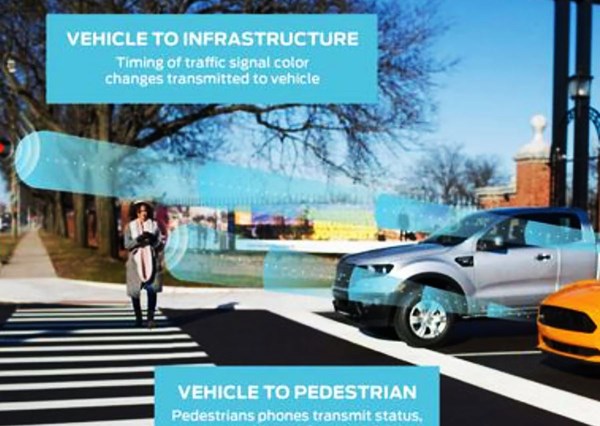Ford Aims to Launch V2X Tech in 2022
Ford Motor Co. plans to equip all of its new vehicles in the U.S. with vehicle-to-everything communication capability starting in 2022.
Ford Motor Co. plans to equip all of its new vehicles in the U.S. with vehicle-to-everything communication capability starting in 2022.
The system will use 5G technology communication, which is just starting to become available in commercial applications. The cellular-based system, dubbed C-V2X, uses existing mobile networks rather than the wireless dedicated short-range communication (DSRC) standard that would require its own network for widespread use.

Ford envisions using C-V2X to allow vehicles to share information with other connected vehicles, pedestrians and the infrastructure. The information would augment sensors used in advanced driver-assist systems and future autonomous vehicles to improve safety, traffic flow and convenience, according to the carmaker.
Information would be sent directly between connected devices rather than passing through cell towers to enable faster communications, Ford says.
Potential applications include communications with traffic signals to alert drivers when a nearby light is about to change. Road signs could alert drivers about recent accidents and congestion, and suggest alternative routes.
At four-way stops, C-V2X also could identify which vehicle has the right-of-way. Cars involved in accidents could provide updates on their status to approaching vehicles. Pedestrians and bicyclists with smartphones also could convey their location to vehicles.
Ford is working with Qualcomm Inc. on the technology, which will be compatible with Ford’s current Co-Pilot360 driver-assist system. The carmaker plans to launch its first fully autonomous vehicles in 2021.
Don Butler, executive director of Ford’s connected vehicle platform and product, posted a blog about the C-V2X system HERE.
RELATED CONTENT
-
Increasing Use of Structural Adhesives in Automotive
Can you glue a car together? Frank Billotto of DuPont Transportation & Industrial discusses the major role structural adhesives can play in vehicle assembly.
-
Mustang Changes for 2018
On Tuesday Ford unveiled—using the social media channels of actor Dwayne Johnson (this has got to unnerve some of the auto buff book editors)—the 2018 Mustang, which has undergone some modifications: under the hood (the 3.7-liter V6 is giving way to a 2.3-liter EcoBoost four, and a 10-speed automatic is available), on the dash (a 12-inch, all-digital LCD screen is available for the dashboard), at the tires (12 wheel choices), on the chassis (MagneRide damper technology is being offered with the Mustang Performance Package), and on the exterior (three new paint colors). And while on the subject of the exterior, there are some notable changes—a lower, remodeled hood, repositioned hood vents, new upper and lower front grilles, LED front lights, revised LED taillamps, new rear bumper and fascia.
-
GM Is Down with Diesels
General Motors is one company that is clearly embracing the diesel engine.








